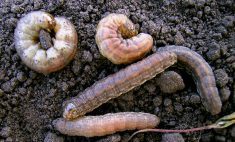A little preparation prior to harvesting can ensure worry-free winter crop storage.
“Warm or wet conditions at harvest and multi-staged crops are potential ingredients for storage problems,” said provincial crop specialist Harry Brook. “Don’t get an unpleasant surprise when selling the grain with discounts or by being rejected for heated grain or insect problems.”
Clean up spilled grain from around the bins to prevent them becoming breeding sites for beetles.
“Most empty grain bins will have some form of insect or mites feeding on the cereal crop residue,” said Brook. “These bins need to be swept or vacuumed out with the debris being either burned or buried.
Read Also

Farming Smarter receives financial boost from Alberta government for potato research
Farming Smarter near Lethbridge got a boost to its research equipment, thanks to the Alberta government’s increase in funding for research associations.
“Malathion can be sprayed into a bin to control insects in the nooks and crannies feeding on crop debris, but only in those bins that will be used to store cereals. It is forbidden to use malathion in bins used to store oilseeds. Empty bins can also be treated with diatomaceous earth prior to storing all crops. Diatomaceous earth can also be added to the crop as the bin is filling as a preventive measure.”
Storing the crop is also risky, especially with hot or damp grain.
“Safe storage is a combination of both the temperature of the grain and its moisture level when stored,” said Brook, who recommends producers consult the Grain Storage web page on the Government of Alberta website for a list of crops and the maximum moisture content.
“Grain aeration is best used in the fall to cool the crop temperatures down, allowing crop to be safely stored over the winter,” he added, although that requires warmer temperatures and low humidity.
“Fall temperatures will continue to drop, lengthening the time it takes to bring moisture levels down,” said Brook. “Even dry, hot grain placed in a bin creates moisture migration. It takes time for grain to stop respiring and moisture to equalize in the bin.”















